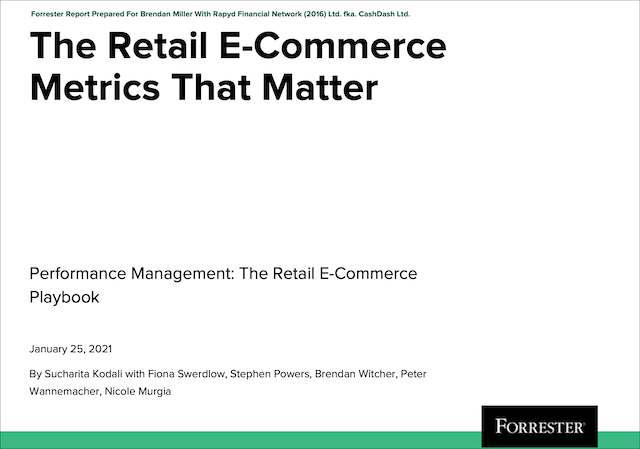Forrester’s Report, The Retail Ecommerce Metrics That Matter, Details the Metrics Critical for Measurement, Ecommerce Success.
To achieve key business goals such as increasing retail sales, digital business retail executives need to ensure that they have the right ecommerce metrics in place. These metrics should track customers’ use of various touchpoints and devices, identify opportunities for enhancements or new features, and help quantify the bottom-line performance of the website.
For true growth, merchants must recognize that the right metrics, not just the easy ones, will improve ecommerce. It’s critical that merchants use metrics that measure both customer and business objects. This article lays out these metrics, recommends how to align them with business objectives, and offers a step-by-step process for collecting and using these metrics. This article summarized a previously published report.
Here Are The Retail eCommerce Metrics that Forrester Says Matter
Table of Contents
- Here Are The Retail eCommerce Metrics that Forrester Says Matter
- What are the Metrics Critical for Measuring Ecommerce Success?
- Step One: Identify What You Can Measure
- Forrester’s The Retail Ecommerce Metrics That Matter Report
- Step Two: Establish Metrics In Four Categories
- Step Three: Collect The Data
- Putting Metrics at the Center of Your Ecommerce Strategy
What are the Metrics Critical for Measuring Ecommerce Success?
The most important metrics largely depend on each company’s goals. The key is to start with the metrics that you must monitor, measure, and improve to be competitive; then prioritize the data you need to do that. Below we explore common metrics and discuss the processes you can use to let the metrics guide your retail ecommerce success.
Step One: Identify What You Can Measure
Site analytics are deeply embedded within the operations of most e-commerce companies, but data about a company’s overall digital retail performance and success rests in sources outside of a traditional analytics solution. Typical metrics include looking at site data, usability, customer experience and cross-channel behavior. For more specific examples of what metrics to use, download the full report.
- Site data. E-commerce is now well over two decades old, so performance metrics are well established and benchmarks for strong and weak performance are prevalent throughout the industry. The metrics that retail e-commerce executives most commonly review are conversion, average order value, shopping cart abandonment, sales generated from marketing programs, and time on the site.
- Usability. Site metrics often tell a story after the fact, but the most rigorous organizations also tap into customer feedback and employ usability labs that try to predict how shoppers will react to changes in a site’s layout or functionality. Focus groups, persona development, A/B testing, and heuristic analyses are a few of the tactics that retailers use to assess whether shoppers can easily find content and achieve their goals on a retail site.
- Customer experience (CX). CX metrics explore how customers feel about their engagement with the retailer. Retailers must combine CX metrics with more traditional metrics, such as site performance and download times, to understand how the total experience works for the customer. Teams routinely gather CX data points from other sources that monitor a site’s infrastructure and stress-test the site to ensure that pages load properly and sources like voice-of-the-customer analysis. These can come from emails, call center phone inquiries and social posts — as well as formal and informal customer interviews and conversations during store visits.
- Cross-channel behavior. Our data shows that 44% of US online adults regularly purchase products offline after researching them online, and 27% regularly purchase products online after researching them offline. Most retailers have unified customer databases across touchpoints. With profile data that can identify which shoppers buy at which touchpoints, retailers can understand dynamics such as online-to-offline conversion or desktop-to-mobile handoffs. Retailers that force customers to log into a site will find it relatively easy to understand device switching. For others, loyalty programs are often the key to identifying shoppers across touchpoints.

Step Two: Establish Metrics In Four Categories
Deciding what you should measure depends on your goals — from increasing the number of shoppers and buyers to choosing which features to roll out next. Some, but not all, will be similar to the metrics your firm already uses.
Broadly speaking, the ecommerce metrics that matter fall into the following categories of awareness and adoption, use, experience, and impact, all of which report explains with greater specificity.
- Awareness and adoption. The first step in driving e-commerce use is making sure that consumers are aware of all of your digital touchpoints. Retailers should use internal or third-party survey data to understand awareness among current customers and prospects of the traditional e-commerce site as well as mobile web and apps. To measure digital touchpoint adoption, we recommend measuring the number of active browsers and buyers across your most critical digital touchpoints.
- Use. The most important metrics for a digital retail business center on how your customers use and engage with various site features. Usage data can reveal a lot about what is and isn’t working. Metrics like page views per user, time on the site, page and cart abandonment will expose problems and opportunities. It’s fairly standard now for retailers to look at these metrics by customer segments, such as new versus repeat users, sale shoppers, or buyers in certain subcategories.
- Experience. Customers want their experiences with websites, apps, and mobile sites to be three things: useful, easy, and enjoyable. Digital retail teams should measure whether or not customers believe their experiences across different touchpoints meet these three criteria. Retailers can assess themselves by gathering Net Promoter Scores or simply asking customers in email or pop-up surveys (e.g., exit surveys) if they achieved their goals after visiting the site.
- Impact. Ultimately, retail executives need to understand and quantify the effect that digital commerce has on enterprisewide revenue and profitability. Take care to measure users’ behavior before and after they purchase for the first time in a given touchpoint, rather than simply comparing them with customers who do not use any form of digital touchpoint.
Step Three: Collect The Data
Different data sources can fuel your dream list of metrics that track your omnichannel fulfillment services performance. It’s essential to start with the metrics that you must monitor, measure, and improve to be competitive. From there, you should prioritize the data you need to do so. If you start with the data that you think you might want or need, you are likely to head down the wrong path — and quickly.
- Digital analytics tools. Most data points that retailers look at on a daily basis — in particular, those about site sales, including mobile traffic and conversion — come from traditional site analytics providers like Adobe, Google, and IBM. Combining analytics and reports from multiple sources using business intelligence (BI) tools often yields deeper insights and more actionable results, such as understanding the impact of stock availability on repeat purchasing. Retailers can also use associate enablement tools in the physical store to enhance the customer experience and improve labor and store operations efficiency.
- Analytics beyond the retailer’s web or mobile site. Retailers must monitor not only how customers use their site but also how they find and get to it. Then study paid and organic search and other traffic-driving sources, such as digital advertising and email, along with shopper data, customer service metrics, and competitive benchmarks. Digital analysts synthesize these metrics along with web and mobile performance to provide regular reports or dashboards for their business.
- Customer surveys and panels. Analytics providers and internal analysts rely on inferences from actual data in a live shopper setting. However, customer surveys and panels (including focus groups) provide retailers with self-reported data about why shoppers behave the way they do — and can provide insight into what features matter most and least to them. Both types of data (inferred and self-reported) are critical to understanding what people do and why they do it. Among retail e-commerce businesses, Bizrate Insights and ForeSee, among others, have been two common partners for customer insights.
Three fundamental data sources include digital analytics tools, customer surveys and panels, and analytics beyond the retailer’s web or mobile site, all of which the report details with great specificity. The guide then explains tips for putting metrics at the heart of your ecommerce strategy.
Putting Metrics at the Center of Your Ecommerce Strategy
If you’re ready for a detailed list of retail ecommerce metrics and to learn how to put metrics at the heart of your ecommerce strategy, then download your copy of the Forrester report to learn actionable steps for measuring your success.
Subscribe Via Email
Thank You!
You’ve Been Subscribed.



